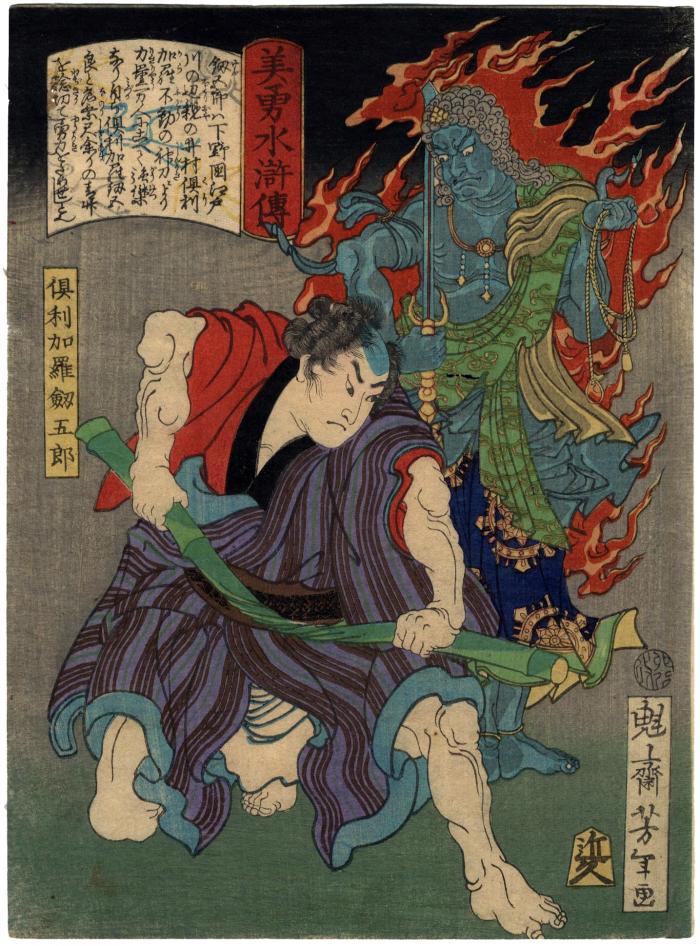Tsukioka Yoshitoshi (月岡芳年) (artist 04/30/1839 – 06/09/1892)
Kurikara Kengorō (倶利加羅剱五郎) twisting a thick piece of bamboo - from the series Sagas of Beauty and Bravery (Biyū Suikoden - 美勇水滸伝)
08/1867
7 in x 9.5 in (Overall dimensions) Japanese woodblock print
Signed: Kaisai Yoshitoshi ga
魁斎芳年画
Publisher: Ōmiya Kyūjirō (Marks 415 - seal 30-034)
Combined date and aratame censor seal: 8/1867
Museum of Fine Arts, Boston
Marega Collection, Universita Pontificia Salesiana
Bibliothèque nationale de France - #37 in an album
The National Gallery of Victoria.
Minneapolis Institute of Arts - the full uncut sheet with two different prints on it
Musée d’art et d’histoire, Ville de Genève
Bayerische Staatsbibliothek, München Illustrated:
1) in color in Japanese Warrior Prints 1646-1905 by James King and Yuriko Iwakiri, Hotei Publishing, 2007, page 340. The text in the book on page 341 reads: "While Fudō Myōō... watches, Kurikara Kengorō - who has prayed to Fudo to give him physical strength - twists a thick piece of bamboo to see if he has been granted his wish. The writing on this work reads in part: 'Kengorō, a peerless strong man, was given his divine power by the Acala God (Kurikara Fudō) at Oyanoi village by the Edo River in Shimonosuke Province."
2) in color in Yoshitoshi: Masterpieces from the Ed Freis Collection, Hotei Publishing, 2011, #48, page 85. On an uncut, double sheet along with a print of Hohodemi no Mikoto riding on a sea bream.
****
The name Kurikara
The name Kurikara is used for both the sword and the dragon, which is often seen wrapped around it, are manifestations of Fudō Myōō, who holds in his right hand - although the dragon is not shown in this print. "Fudo is the patron of ascetics and warriors in Japan, and with his sword, Kurikara, he destroys delusions and severs attachments that stand in the way of the aspirant... The relationship between the sword and dragon is explained in the Kurikara Dharani Kyo (the sutra of the Kurikara incantation), which tells the story of a battle between Fudo and a demonic adversary. The demon metamorphoses into a sword, and Fudo does likewise; the fight continues without result until Fudo transforms himself again, this time from a sword into a dragon; he then consumes the; he then consumes the heretic's sword inflames."
Quoted from the introduction to Kurikara: The Sword and the Serpent by John Maki Evans, Blue Snake Books, 2011, pages xv and xvii.
Marinus Willem de Visser wrote on page 204 of The Dragon in China and Japan:
"∮ 8. Kurikara Myo-o, the dragon-shaped mountain god."
"Another Shinto shrine, the temple of Kurikara Myo-o, 倶梨迦羅明王. is dedicated to a dragon-shaped mountain-god, who is said to live in a waterfall on Mount Oyama in Sagami province. As the Nihon shukyo fuzoku shi (1902) tells us, in olden times the Buddhist priest Ryoben was preaching there one day, when a violent thunderstorm suddenly arose and the water in the hollow, excavated by the cataract, was heavily disturbed. A huge dragon came forth from it and said to the priest: "I am the guardian-god of this mountain. After having heard your sermon, I wish to serve Buddha." Then Ryoben worshipped the dragon, and afterwards as [sic] little Shinto shrine was built on the spot and dedicated to the dragon, which was called by the Buddhist name "Kurikara Myo-o", "Kurikara, the Light-King" (i.e. Vidya-rȧja, the word Light being used in the sense of (mystic) Knowledge, Vidyā)."
"This was apparently an original Japanese dragon-shaped mountain-god, who was identified by the Buddhists with Fudo Myo-o's dragon-shape; the Shinto shrine, however, remained his sanctuary. Kurikara is, as we read in Miura's Bukkyo iroha jiten, Fudo Myo-o's "Samaya (三摩耶) shape, a black dragon coiled around a sword."
Originally printed in 1924, but this quote is from a reprint in 2012, published by Forgotten Books.
****
"The chūban prints from this series were printed two to a block and then cut... The production of the set lasted from 4/1866-4/1867. Once completed, it was issued with an unsigned, undated title page and a contents page that itemised all fifty prints, with the signature Ikkaisai Yoshitoshi ga (picture by Ikkaisai Yoshitoshi) and the name of Kanagaki Robun in the left margin."
Quoted from: Yoshitoshi: Masterpieces from the Ed Freis Collection, page 85. The authors note that there appears to be a later edition where the publisher's seal has been left blank.
****
There are 8 other images from this series in the Lyon Collection (#s 404, 1076, 1103, 1104, 1155, 1156, 1188 and 1189), plus the frontispiece (#1191) and title page (#1190).
Ōmiya Kyūjirō (近江屋久次郎) (publisher)
Suikoden (水滸傳) (genre)
warrior prints (musha-e - 武者絵) (genre)
Fudō Myōō (不動明王) (role)
Kanagaki Robun (仮名垣魯文) (author)
